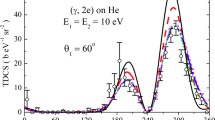Summary
It is the aim of the present paper to establish an improved formula for the non-relativistic primary specific ionization of electrons in helium, as a result of a carefully developed theory in which numerically computed helium wave functions are introduced instead of less accurate hydrogenic wave functions. Sect.1 presents the calculation of the differential cross section for inelastic scattering of an incident electron by a helium atom on the basis of a well-known method for treating rearrangement collisions which makes use of the Born approximation. In Sect.2, the resulting formula is applied to the specific problem under consideration and it is first shown that the terms due to spin-exchange effects can be neglected under the prevailing conditions of validity. The various parts of the remaining simplified formula for the differential cross section are then calculated explicitly and in Sect.3, the necessary summations and integrations which ultimately lead to the primary specific ionizationS(β), are carried out. One of these integrations is studied in particular detail since it necessitates the introduction of additional simplifying approximations. The new final result forS(β) is discussed and compared with a frequently adopted formula derived from the classical work of Bethe on primary specific ionization. A graphical representation also permits a comparison with some experimental data. The main conclusion is that the new formula is able to account for as much as 25% of the discrepancy between Bethe’s formula and the experimental points. The remaining deviation can be physically understood. Finally, Sect.4 is devoted to the velocity distributions of the secondary electrons ejected from the helium atoms during the process of primary ionization in various quantum states of angular momentum characterized by the non-negative integerl. The general behavior of the cross sections per unit ϰ-interval (ϰ being a convenient dimensionless velocity parameter) corresponding tol=0, 1 and 2 is discussed and physically interpreted. These cross sections are also compared with their respective analytic counterparts in which Coulomb wave functions are used to describe the final states of the ejected electrons approximately. It turns out that the agreement is excellent forl=2 as well as for all higherl-values.
Riassunto
Scopo del presente lavoro è di stabilire una formula migliorata per la ionizzazione specifica primaria non relativistica degli elettroni in elio, come risultato di una teoria accuratamente sviluppata in cui vengono introdotte le funzioni d’onda dell’elio calcolate accuratamente invece delle meno accurate funzioni d’onda dell’idrogeno. La Sezione1 presenta il calcolo della sezione trasversale differenziale per lo scattering anelastico di un elettrone incidente su un atomo di elio in base al ben noto metodo per trattare le collisioni di riassestamento, che fa uso dell’approssimazione di Born. Nella Sezione2 la formula risultante viene applicata al problema specifico considerato e si mostra in primo luogo che i termini dovuti ad effetti di scambio di spin possono essere trascurati nelle condizioni di validità prevalenti. Le varie parti della restante formula semplificata per la sezione d’urto differenziale vengono poi esplicitamente calcolate e, nella Sezione3, vengono eseguite le sommatorie e gli integrali necessari, che infine conducono alla ionizzazione specifica primariaS(β). Una di queste integrazioni viene studiata in modo particolarmente dettagliato in quanto necessita della introduzione di ulteriori approssimazioni semplificatrici. Si discute il nuovo risultato finale perS(β), che viene messo a raffronto con una formula frequentemente usata derivata dal classico lavoro di Bethe sulla ionizzazione specifica primaria. Una rappresentazione grafica permette pure un confronto con alcuni dati sperimentali. La conclusione principale è che la nuova formula può spiegare sino al 25% del disaccordo fra la formula di Bethe ed i punti sperimentali. Il resto della differenza può essere compreso fisicamente. Infine la Sezione4 è dedicata alle distribuzioni delle velocità degli elettroni secondari emessi dagli atomi di elio durante il processo di ionizzazione primaria in vari stati quantici del momento angolare caratterizzati dall’intero non negativol. Si discute e si interpreta fisicamente il comportamento generale delle sezioni d’urto per intervalli ϰ unitari (essendo ϰ un conveniente parametro della velocità adimensionale) corrispondenti al=0, 1 e 2. Queste sezioni d’urto sono anche confrontate con le corrispondenti espressioni analitiche in cui si usano le funzioni d’onda di Coulomb per descrivere approssimativamente gli stati finali degli elettroni emessi. Ne risulta che la concordanza è eccellente perl=0 e per tutti i valori dil maggiori.
Similar content being viewed by others
References
C. C. Grosjean andR. T. Van de Walle:Nuovo Cimento,19, 696 (1961).
L. I. Schiff:Quantum Mechanics (New York, 1949), pp. 230–239.
H. A. Bethe:Ann. d. Phys.,5, 325 (1930).
C. Møller:Zeits. f. Phys.,70, 786 (1931).
J. Allewaert, R. Van de Walle andJ. Verhaeghe:Comp. Rend. Acad. Sci. Paris,245, 1611 (1957).
R. Van de Walle andJ. Verhaeghe:Compt. Rend. Acad. Sci. Paris,248, 3292 (1959).
R. Van de Walle andJ. Verhaeghe:Compt. Rend. Acad. Sci. Paris,245, 1721 (1957).
Author information
Authors and Affiliations
Rights and permissions
About this article
Cite this article
Van de Walle, R.T., Grosjean, C.C. On the theory of primary specific ionization in helium. Nuovo Cim 19, 872–902 (1961). https://doi.org/10.1007/BF02731232
Received:
Published:
Issue Date:
DOI: https://doi.org/10.1007/BF02731232




